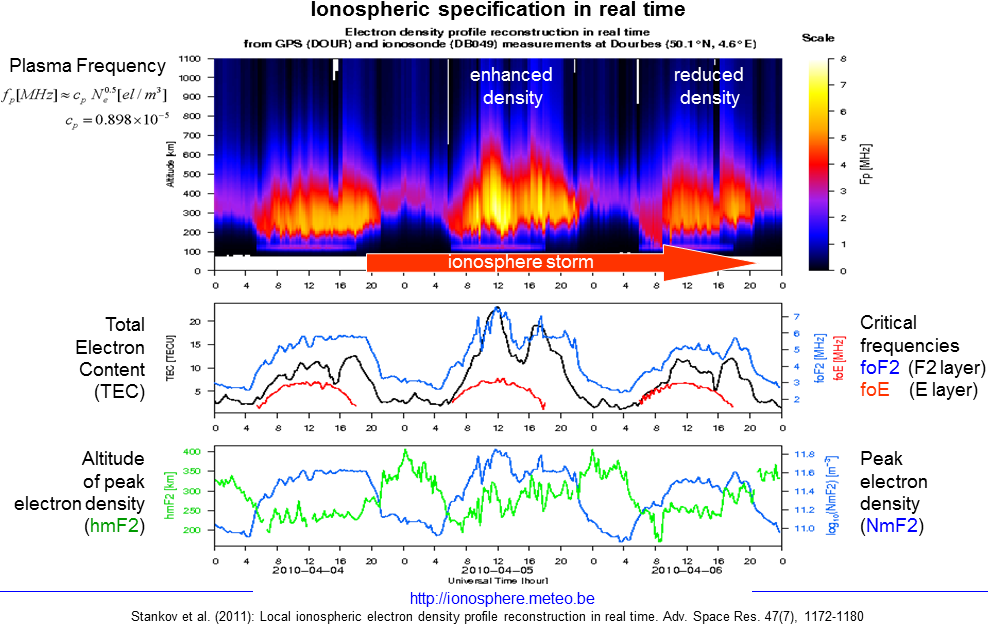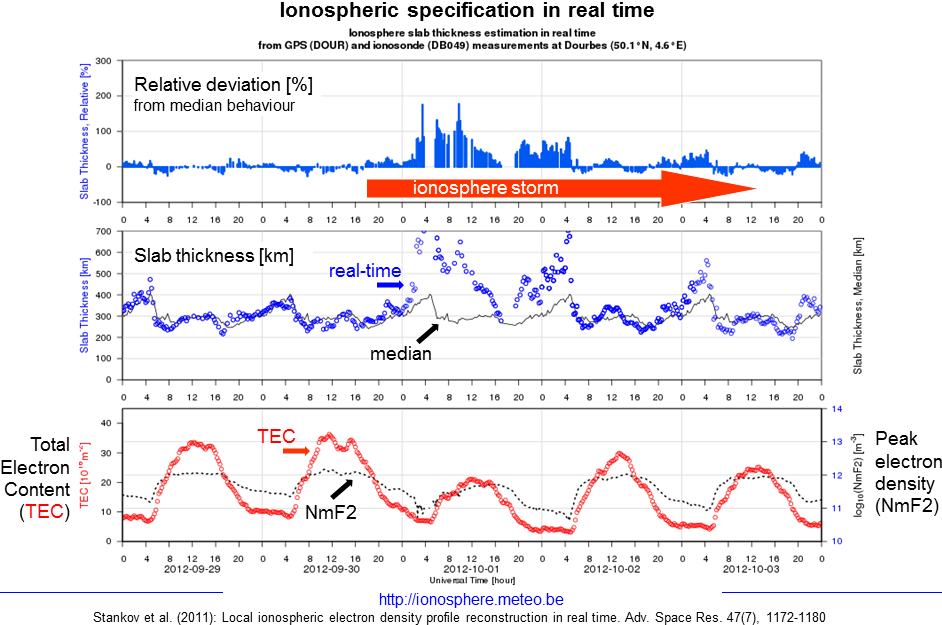Ionospheric Modelling
The purpose of the LIEDR (Local Ionospheric Electron Density profile Reconstruction) system is to acquire and process data from simultaneous ground-based GNSS TEC and digital ionosonde measurements, and subsequently to deduce the vertical electron density distribution in the local ionosphere (Stankov et al., 2011). LIEDR is primarily designed to operate in real time for service applications, and, if sufficient data from solar and geomagnetic observations are available, to provide short-term forecast as well. For research applications and further development of the system, a post-processing mode of operation is also envisaged. In essence, the reconstruction procedure consists in the following. The high-precision ionosonde measurements are used for directly obtaining the bottom part of the electron density profile. The ionospheric profiler for the lower side (i.e. below the density peak height, hmF2) is based on the Epstein layer functions using the known values of the critical frequencies, foF2 and foF, and the propagation factor, M3000F2. The corresponding bottom-side part of the total electron content is calculated from this profile and is then subtracted from the GPS TEC value in order to obtain the unknown portion of the TEC in the upper side (i.e. above the hmF2). Ionosonde data, together with the simultaneously-measured TEC and empirically obtained O+/H+ ion transition level values, are all required for the determination of the topside electron density scale height. The topside electron density is considered as a sum of the constituent oxygen and hydrogen ion densities with unknown vertical scale heights. The latter are calculated by solving a system of transcendental equations that arise from the incorporation of a suitable ionospheric profiler (Chapman, Epstein, or Exponential) into formulae describing ionospheric conditions (plasma quasi-neutrality, ion transition level). Once the topside scale heights are determined, the construction of the vertical electron density distribution in the entire altitude range is a straightforward process. As a by-product of the described procedure, the value of the ionospheric slab thickness can be computed instantaneously.
The LIEDR procedure has been implemented at the RMI Geophysics Centre in Dourbes (50.1°N, 4.6°E) where a GPS receiver is collocated with a digital ionosonde (URSI code: DB049, type: Lowell Digisonde 4D). Currently, the nominal time resolution between two consecutive reconstructions is set to 5 minutes. Several applications are envisaged. For example, the ionospheric propagation delays can be estimated and corrected much easier if the electron density profile is available at a nearby location on a real-time basis. Also, both the input data and the reconstruction results can be used for validation purposes in ionospheric models, maps, and other monitoring services. Here is a link to the LIEDR operational service.
LIEDR is being constantly upgraded. For example, based on the detailed analyses of topside sounder data (Verhulst and Stankov, 2013; 2014; 2015), we are now able to more adequately model the topside ionospheric plasma distribution. Also, the behaviour of the altitudinal solar terminator for a given location has been thoroughly investigated together with the influence of the height-dependent sunrise and sunset on the ionospheric E and F layers (Verhulst and Stankov, 2017). As a result, mathematical formulae have been deduced, and an algorithm developed, for calculating the height of the terminator as a function of the geographic latitude and the day of year. The algorithm has been successfully implemented and proved to be efficient in substantially improving the reconstruction of the vertical electron density profile by minimizing, and in many cases even eliminating, the discrepancies between consecutive profiles that used to occur during sunset when switching from day-time to night-time profilers.

The ionospheric slab thickness, the ratio of the Total Electron Content (TEC) to the maximum ionospheric F2-layer electron density (NmF2), offers substantial information on the shape of the electron density profile, the neutral and ionospheric temperatures/gradients, on the ionospheric composition and dynamics, etc. For example, sharp changes in slab thickness can be attributed to physical processes occurring during geomagnetic storms, such as plasma uplifting, enhanced plasma fluxes from/to the plasmasphere, etc. The ionospheric monitoring capabilities of the slab thickness remain largely unexplored, despite the fact that, operationally, it is a very useful parameter because it allows a simple conversion between the critical frequency (foF2) and TEC and additionally, it closely relates to other important ionospheric characteristics. From this aspect, various possibilities exist for utilising the ionospheric slab thickness modelling/monitoring efforts (Stankov and Warnant, 2009). For example, if having instantaneous access to data from regional/global digital ionosonde and GNSS reference networks, it would be possible to provide regional/global monitoring of the slab thickness in real time. If available in real time, over a location/region of interest, the operational slab thickness monitoring can be used for characterizing and eventually predicting the ionospheric density distribution/gradients, the extent of ionospheric density anomalies and their propagation characteristics, etc. Thanks to the regular digital ionosonde and GNSS TEC measurements carried out at Dourbes, a monitoring system has been developed to provide better real-time ionospheric characterization and understanding of the local ionospheric dynamics. Here is a link to the local ionospheric slab thickness operational service.

References:
Jodogne, J.C., S.M. Stankov (2002): Ionosphere-plasmasphere response to geomagnetic storms studied with the RMI-Dourbes comprehensive database. Annals of Geophysics, Vol.45, No.5, pp.629–647. (doi:10.4401/ag-3529) (download)
Stankov, S.M., R. Warnant (2009): Ionospheric slab thickness – Analysis, modelling and monitoring. Advances in Space Research, Vol.44, No.11, pp.1295–1303. (doi:10.1016/j.asr.2009.07.010) (download)
Stankov, S.M., K. Stegen, P. Muhtarov, R. Warnant (2011): Local ionospheric electron density profile reconstruction in real time from simultaneous ground-based GNSS and ionosonde measurements. Advances in Space Research, Vol.47, No.7, pp. 1172–1180. (doi:10.1016/j.asr.2010.11.039) (download)
Verhulst, T., S.M. Stankov (2013): The topside sounder database – data screening and systematic biases. Advances in Space Research, Vol.51, No.11, pp.2010–2017. (doi:10.1016/j.asr.2012.12.023) (download)
Verhulst, T., S.M. Stankov (2014): Evaluation of ionospheric profilers using topside sounding data. Radio Science, Vol.49, No.3, pp.181–195. (doi:10.1002/2013RS005263) (download)
Verhulst, T., S.M. Stankov (2015): Ionospheric specification with analytical profilers: Evidences of non-Chapman electron density distribution in the upper ionosphere. Advances in Space Research, Vol.55, No.8, pp.2058–2069. (doi:10.1016/j.asr.2014.10.017) (download)

